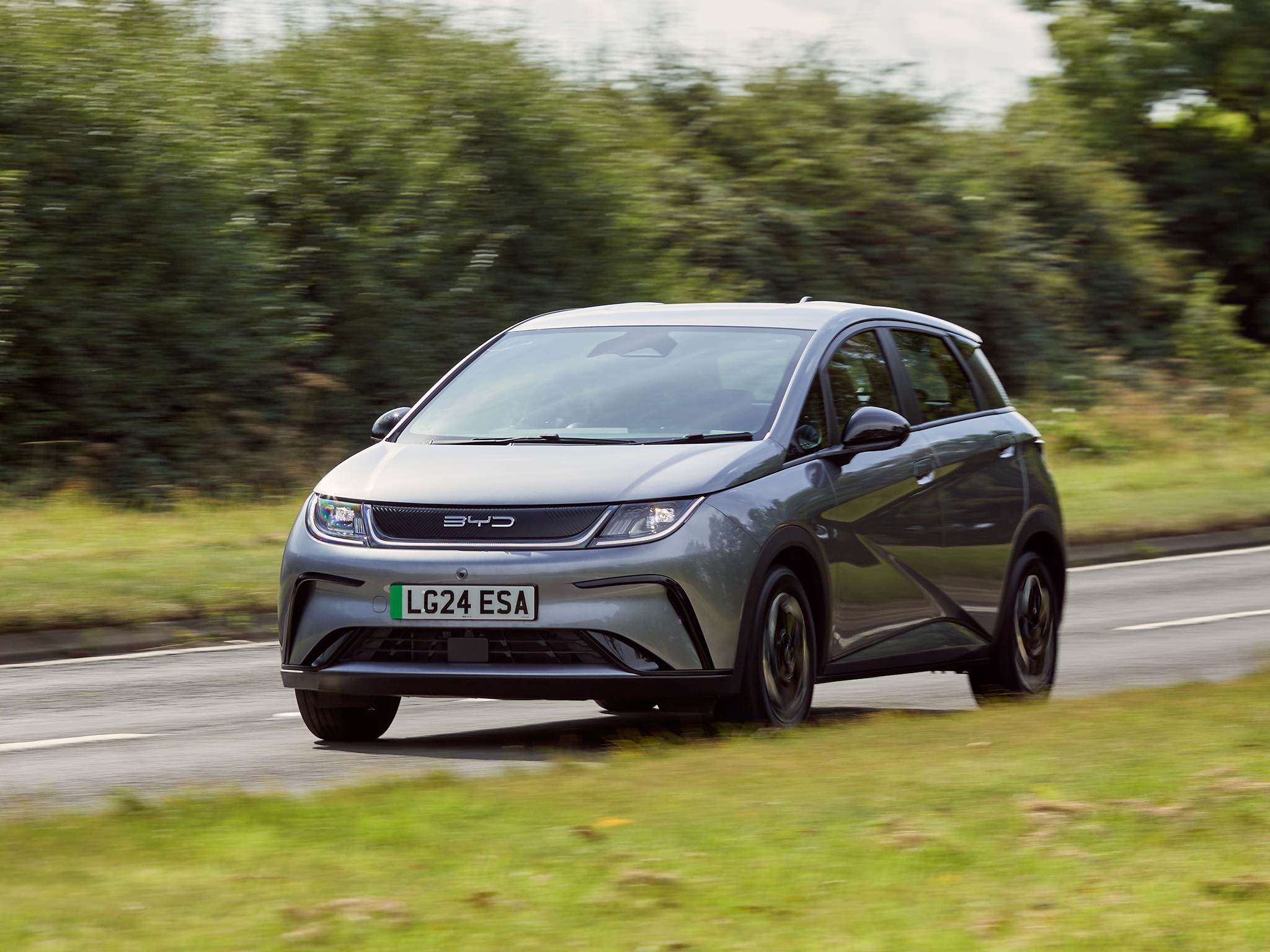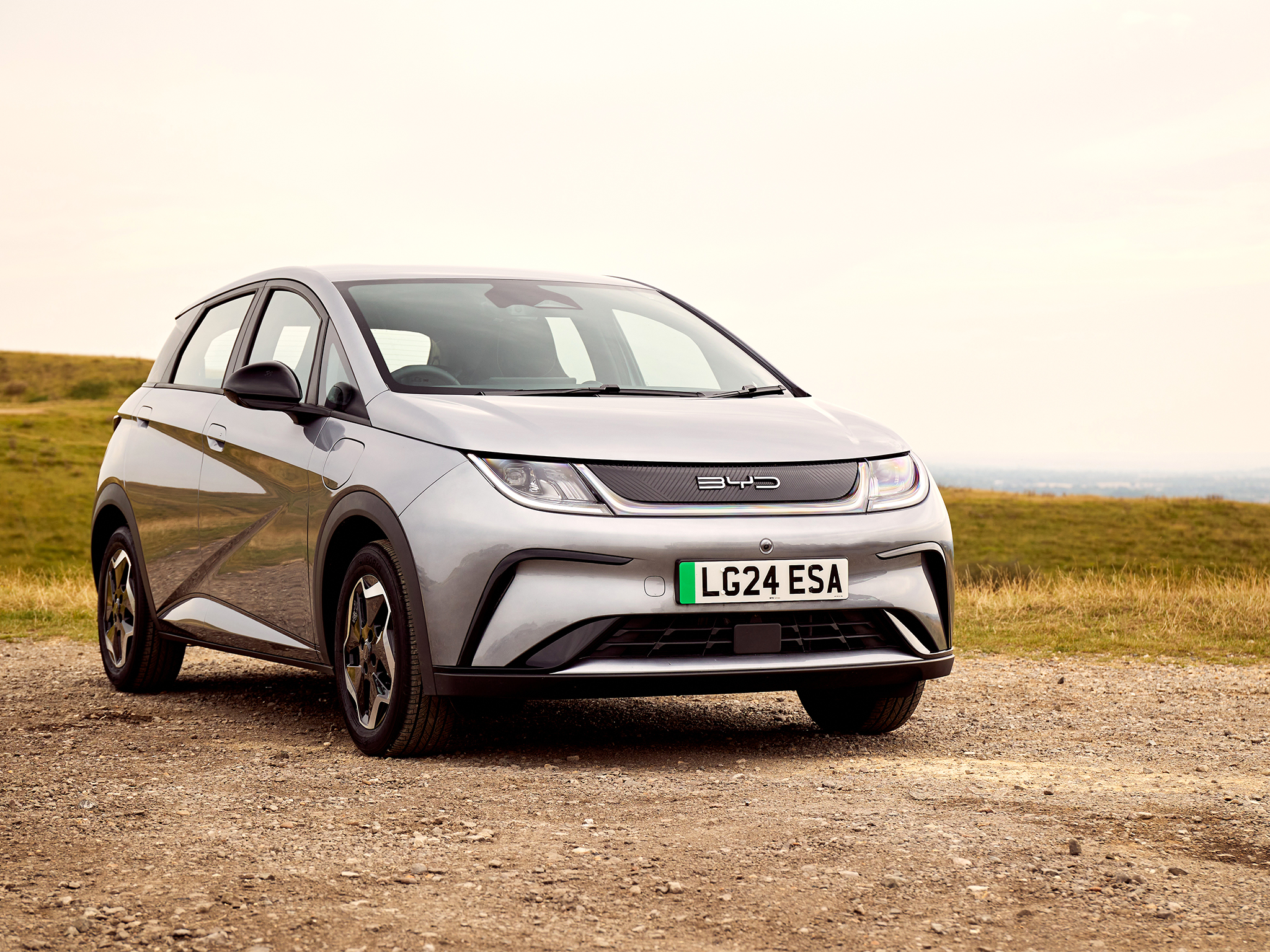BYD Dolphin review: Compact electric hatchback at an attractive price
The BYD Dolphin is a compact electric hatchback with a spacious, nicely designed interior, a good amount of kit as standard and an attractive price

The Independent's Electric Vehicles Channel is sponsored by E.ON Next.
The BYD Dolphin is an entry-level EV hatchback that features an interior that is spacious, practical and nicely designed. Although the exterior is forgettable, the Dolphin has a good amount of kit fitted as standard and the circa-200 mile range is decent for a car of this size and price. It’s comfortable, quiet and rides well, although it can become unsettled on bumpy roads and the brake pedal is on the soft side.
We’d avoid the entry-level Active trim as it feels rather underpowered by modern standards; upgrading to the quicker Boost trim is £1,000 well spent, although mediocre charge speeds mean a 10-80 percent fill will take at least 38 minutes.
How we tested
I spent half a day driving the BYD Dolphin on a range of roads in Berkshire and Surrey Area. These included residential streets, country lanes and dual carriageways.
BYD Dolphin: From £26,195, BYD.com

Independent rating: 7/10
- Pros: Well-equipped, decent range, nicely designed cabin
- Cons: Active model is underpowered, relatively slow charging, forgettable exterior design
- Price range: £26,195 to £31,695
- Battery size: 44.9 to 60.4 kWh
- Maximum claimed range: 195 to 265 miles
- Miles per kWh: 3.9 to 4.08
- Maximum charging rate: 65 to 88 kW
- Charging cost per 100 miles on E.ON Next Drive: £1.64
Battery, range, charging, performance and drive
There are four models of Dolphin to pick from, called the Active, Boost, Comfort and Design. The first two have a 44.9 kWh battery for between 195 miles (Boost) and 211 miles (Active), and a maximum charge speed of just 65 kW, meaning a fill from 10 to 80 percent takes at least 38 minutes. The cheaper Active is the less powerful of the two, producing 93 bhp and reaching 62 mph in a leisurely 12.3 seconds; the Boost has 172 bhp and covers the same sprint in a more spritely 7.5 seconds.
The Comfort and Design have a 60.4 kWh battery and a range of up to 265 miles. They charge at up to 88 kW, but the larger capacity means a 10-80 percent fill takes slightly longer, at 40 minutes for a best-case scenario. Both models produce 199 bhp and reach 62 mph in 7.0 seconds. None of these cars are sporty, but that isn’t the point. The BYD Dolphin is an affordable and relatively compact electric hatchback aimed at couples and young families buying their first EV.
Although pleasant enough to drive, the Dolphin lacks composure over undulating roads and the brake pedal is on the squishy side and takes a bit of time to get used to.

Interior, practicality and boot space
Like the Atto 3, BYD has given the Dolphin an interior that’s more stylish than you’d expect from the low price and forgettable exterior. It feels premium and has some nice design details, like the elegantly arched door handles, swooping dashboard and rotating central display. It feels relatively spacious, with more rear legroom than in a Mini Cooper or Vauxhall Corsa. Every version of Dolphin has electrically-adjustable seats, but they lack adjustable lumbar support.
Most controls are on the fiddly touchscreen and the driver display behind the wheel is small, with a cluttered interface, but we like how the wheel has physical buttons instead of touch-sensitive haptic pads. We also like the discreet drive selector and drive mode button on the centre console, which are controlled by rotating them up or down – and without taking your eyes off the road. There are a couple of handy shelves for putting your phone and wallet (one has wireless charging on the Design spec), and although there’s a lot of hard, cheap-feeling plastic, some of the dashboard and door cards are treated to a softer fabric not dissimilar to a wetsuit. It feels better than it sounds, but we wonder how well it’ll age, especially if configured in a brighter colour.
The boot capacity is 345 litres with the rear seats up and there’s a false floor under which you can tidy away your charging cables. There’s no frunk under the bonnet.
Technology, stereo and infotainment
Despite its entry-level price, BYD’s trademark rotating, 12.8-inch touchscreen is fitted to all versions of the Dolphin. It runs a bespoke operating system that looks and feels much like an Android tablet, which should appeal to younger drivers but it’s an interface that can feel cluttered. The same goes for the 5-inch TFT driver display, which isn’t of particularly high quality and some details are tricky to read at a glance.
4G connectivity is standard across the Dolphin range, along with voice control and a couple of USB-C ports up front, plus wired support for both Apple CarPlay and Android Auto. There’s also a 360-degree parking camera on all models, as wella s rear parking sensors (front are on Comfort and Design only), adaptive cruise control, a heat pump, keyless entry and start, and vehicle-to-load (V2L) support, where the battery can be used to power domestic appliances. The unbranded, standard-fit, six-speaker stereo works well enough, but is nothing to write home about.
Prices and running costs
There are relatively few truly affordable EVs out there, at least if you want to buy new. The BYD Dolphin offers more space and practicality than the Vauxhall Corsa Electric, while also being cheaper (and roomier) than the Mini Cooper. The Dolphin also comes with a good amount of kit as standard, also though the entry-level Active feels especially slow by modern standards. This might be fine for town and city driving, but could become tiresome if you have a motorway commute. Costing only £1,000 more, the Boost also benefits from quicker home charging (11 kW compared to 7 kW) and alloy wheels, while losing just 16 miles of maximum range to the Active.
As with all EVs, running costs can be very low if you charge at home. Public chargers are more expensive, often considerably so. Some charge networks offer access to lower prices via monthly or annual subscriptions.

BYD Dolphin rivals
FAQs
How long does it take to charge?
The BYD Dolphin does not charge particularly quickly, with a maximum charge rate of just 65 kW for the Active and Boost models, and 88 kW for the Comfort and Design. Filling from 10 to 80 percent at a public charger takes between 38 and 40 minutes, while a home charge takes between five and seven hours, depending on your charger.
How much does it cost - is it worth it?
At £26,195, the BYD Dolphin is among the cheapest electric cars on sale today. For that you get a good amount of kit as standard and a car that is practical, with a spacious interior and decent range. We recommend spending the extra £1,000 for the quicker and better-equipped Boost model.
Does BYD replace batteries for free?
The BYD Dolphin comes with a battery that covers its battery for eight years or 125,000 miles, whichever comes first. If the battery fails in that time, or its capacity falls below 70 percent, a no-cost replacement could be available.
The verdict: BYD Dolphin
Good value, plenty of kit as standard and a spacious, nicely designed cabin. That’s what you get with the Dolphin – and the extra £1,000 for Boost trim is well worth it.






Join our commenting forum
Join thought-provoking conversations, follow other Independent readers and see their replies
Comments